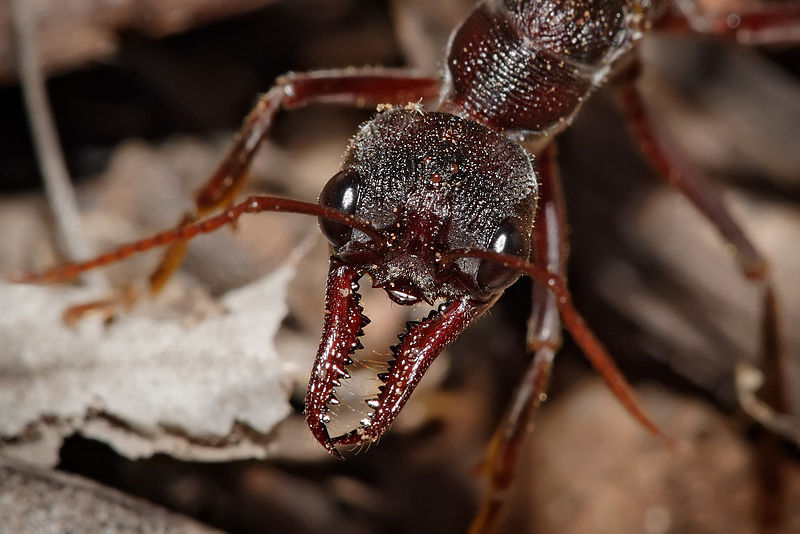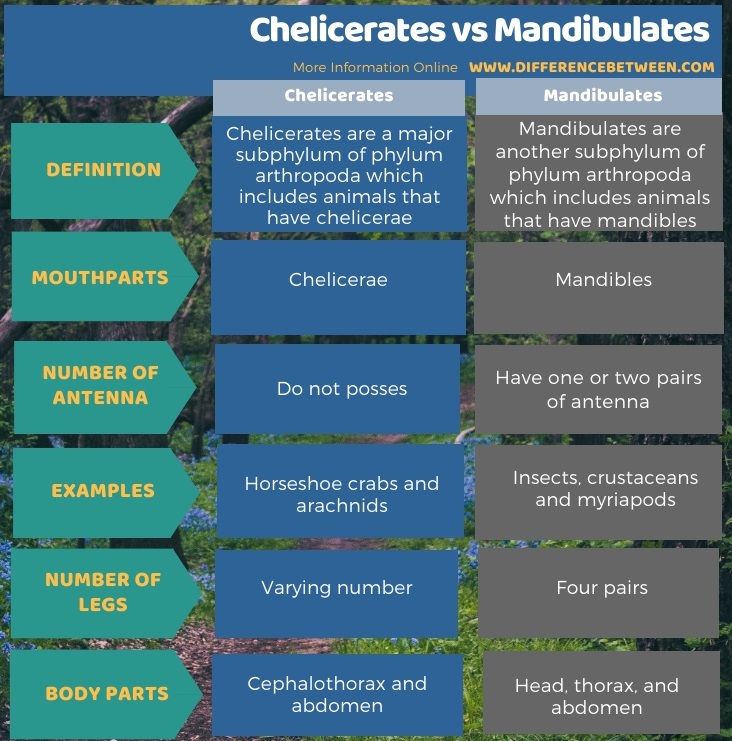The key difference between chelicerates and mandibulates is that chelicerates have chelicerae, while mandibulates have mandibles.
Arthropoda is the largest phylum that belongs to Kingdom Animalia. Therefore, it contains a huge number of animal species having an exoskeleton and joined appendages. They are found in all types of habitats. There are three major groups of arthropods. Chelicerates and mandibulates are two of these three groups. The characterizing feature of chelicerates is the presence of chelicerae. Meanwhile, the characterizing feature of mandibulates is the presence of mandibles. Chelicerae and mandibles are mouthparts.
CONTENTS
1. Overview and Key Difference
2. What are Chelicerates
3. What are Mandibulates
4. Similarities Between Chelicerates and Mandibulates
5. Side by Side Comparison – Chelicerates vs Mandibulates in Tabular Form
6. Summary
What are Chelicerates?
Chelicerates are a major group of arthropods. They have a pair of chelicerae. However, they lack mouthparts for chewing, unlike mandibulates. Hence, they need to predigest food and absorb nutrients in liquid form. Their body can be divided into two main parts as cephalothorax and abdomen. Moreover, they have six pairs of appendages. The first pair is a pair of chelicerae. These organisms do not possess antenna on their head.

Figure 01: Chelicerates
There are two major classes of chelicerates: Xiphosura and Arachnida. Class Xiphosura includes animals like horseshoe crabs, which are marine in nature. Class Arachnida includes animals like scorpions, ticks, mites and spiders, which are terrestrial.
What are Mandibulates?
Mandibulates are a group of arthropods. In fact, they are the largest and most varied group of arthropods. The characterizing feature of organisms belonging to this group is that they have mandibles, which are a pair of mouthparts used for chewing or cutting. There are four classes in the subphylum mandibulates. They are Crustacea (prawns, crabs, lobsters, crab fishes), Chilopoda (centipedes), Diplopoda (millipedes) and Hexapoda (insects).

Figure 02: Mandibulate
The mandibulate body can be divided into head, trunk, thorax and abdomen. Unlike chelicerates, mandibulates have antennas.
What are the Similarities Difference Between Chelicerates and Mandibulates?
- Chelicerates and mandibulates are two major groups of arthropods.
- They have exoskeletons and segmented bodies.
- Moreover, they belong to the largest and most varied phylum of Kingdom Animalia.
- They are found in all most all habitats.
What is the Difference Between Chelicerates and Mandibulates?
Chelicerates are a major subphylum of phylum Arthropoda and include animals that have chelicerae. On the other hand, mandibulates are another subphylum of phylum Arthropoda and include animals that have mandibles. So, this is the key difference between chelicerates and mandibulates. Chelicerates body is divided into cephalothorax and abdomen, while the mandibulates body is divided into head, thorax, and abdomen. Moreover, chelicerates do not possess antenna while mandibulates have one or two pairs of antennae.
The below infographic provides more comparisons related to the difference between chelicerates and mandibulates.

Summary – Chelicerates vs Mandibulates
Chelicerates and mandibulates are two major subphyla of phylum Arthropoda. Chelicerates have chelicerae while mandibulates have mandibles. So, this is the key difference between chelicerates and mandibulates. Moreover, chelicerates have two parts in their body while mandibulates generally have three parts in their bodies. Furthermore, chelicerates lack antenna while mandibulates have a pair of antenna. There are two main classes that belong to chelicerates, while there are four major classes in mandibulates.
Reference:
1. “Mandibulata.” New World Encyclopedia, Available here.
2. “Chelicerata.” Wikipedia, Wikimedia Foundation, 3 Dec. 2019, Available here.
Image Courtesy:
1. “Chelicerata Collage” By Eurypterids Pentecopterus Vertical.jpg: Patrick LynchPycnogonid.jpg: Steve ChildsLimulus polyphemus (aq.).jpg: Hans HillewaertGasteracantha cancriformis 2.jpg: Mike Kullen – Eurypterids Pentecopterus Vertical.jpgPycnogonid.jpgLimulus polyphemus (aq.).jpgGasteracantha cancriformis 2.jpg (CC BY-SA 3.0) via Commons Wikimedia
2. “Bullant head detail” By fir0002flagstaffotos [at] gmail.comCanon 20D + Sigma 150mm f/2.8 – Own work (GFDL 1.2) via Commons Wikimedia
ncG1vNJzZmivp6x7pbXFn5yrnZ6YsqOx07CcnqZemLyue8OinZ%2Bdopq7pLGMm5ytr5Wau26vx56jopuVp661sdJmmKecXaKur7DIm6ylmaSawHA%3D